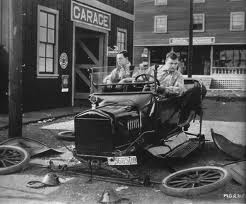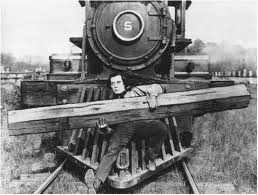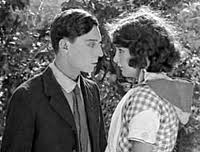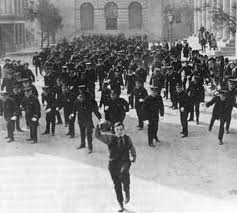Groundbreaking guitarists perform original scores for silent films
by the legendary Buster Keaton
by Yuri Turchyn
 The New York Guitar Festival (NYGF) has been around for ten years exploring many aspects of guitar music through commissioning new work and supporting innovative, multi-media collaborations among outstanding artists. In 2009 NYGF at Merkin Concert Hall, featured artists included Marc Ribot, David Bromberg, among others premiering their music scores to classic silent films by Charlie Chaplin. The 2012 festival pairs performers with another great comic actor-directors in early cinema – Buster Keaton (1895-1966). Silent Films/Live Guitars gives audiences a rare opportunity to see classic Keaton comedies on a big screen, accompanied by some of today’s most distinctive and influential guitarists.
The New York Guitar Festival (NYGF) has been around for ten years exploring many aspects of guitar music through commissioning new work and supporting innovative, multi-media collaborations among outstanding artists. In 2009 NYGF at Merkin Concert Hall, featured artists included Marc Ribot, David Bromberg, among others premiering their music scores to classic silent films by Charlie Chaplin. The 2012 festival pairs performers with another great comic actor-directors in early cinema – Buster Keaton (1895-1966). Silent Films/Live Guitars gives audiences a rare opportunity to see classic Keaton comedies on a big screen, accompanied by some of today’s most distinctive and influential guitarists.
According to NYGF founder and artistic director David Spelman. “These films are nearly a hundred years old, but their humor and visual poetry is still startlingly fresh and vibrant. As for the music we’ve commissioned, I’m excited that artists will be carefully scoring and rehearsing their music, although I also anticipate a good deal of improvisation. This seems utterly appropriate, as Keaton was such a firm believer in improvisation. Described as “an epic event” in The Wall Street Journal and “a veritable guitar orgy” by Jazz Times, the NYGF is hosted by festival co-founder WNYC, John Schaefer and broadcast on WNYC’s New Sounds® Live.
On Thursday, January 12, the opening act was Twi The Humble Feather, an acoustic guitar duo, cousins and close friends since childhood, Anthony Lebron and Hektor Fontanez aim to create timeless and imaginative music for a multi-generational audience. They performed a score for The Garage (1920), a short comedy starring Buster Keaton and Fatty Arbuckle. Interpreting the film in a driving and rhythmic form using an open tuning style harmonically. The players sat askance to the screen and complimented the action in the film impeccably. They punctuated many segments not only with their guitars but also with their voices. The vocal accents were done for segments in the film such as wind or splashing of water in appropriate places.
Brooklyn-based Buke and Gase – Arone Dyer on the “buke” (a self-modified six-string baritone ukulele) and Aron Sanchez on the “gase” (a guitar-bass hybrid of his own creation) performed a score to excerpts from Buster Keaton’s Civil War adventure classic The General (1926), which is famous for its locomotive chase. They edited the film to reduce it to approximately a ten minute segment of the train being stolen by confederate rebels. Both players used foot percussion and various pedals, amplifiers and other homemade inventions in conjunction with their instruments to create a wonderfully unique sound to compliment the action in the movie.
The ukulele that Arone Dyer used was modified to a six string instrument rather than the usual four stringed instrument. The sounds she created to interpret the action were quite compelling. She used a tambourine uniquely strapped to her foot to punctuate certain actions in the film and the ukulele to produce feedback, squeals and more to produce original sounds. Aron Sanchez played a hybrid bass and guitar instrument that he created. The sounds he produced were unique and other worldly. The train sound was a pulsing pattern he played in appropriate spots in the film. Harmonically, the duo relied on an open tuning format with great results.
Third on the bill was Kaki King who collaborated with Pearl Jam’s Eddie Vedder on the Golden Globe-nominated soundtrack for Sean Penn’s Into the Wild. As a soloist in NYGF, she performed on acoustic and electric guitars. She composed her score to Buster Keaton’s 1920 short comedy The Scarecrow (1920) in which Keaton plays a young man whose pursuit of a farmer’s daughter takes an unexpected turn when he falls into a hay thresher and ruins his clothes. Ms. King used, in the opening sequences, an acoustic guitar that featured a hollow neck and played it lap style and in open tuning. She switched to a regular acoustic and then electric guitar in the subsequent segments of the film very appropriately. When switching instruments, she used the Echoplex device to loop the last phrase that she played giving her the time necessary to advance to the next instrument to compliment the scenes in the film. Very well done.
Finally, co-founder of the alternative rock band Sonic Youth, Lee Ranaldo performed an original score to Buster Keaton’s Cops (1922), a short comedy about a young man who gets on the bad side of the Los Angeles Police Department during a parade and is chased all over town. This was performance art with the movie as background. Introducing his work, Mr. Ranaldo spoke of his approach to “scoring” the movie as improvisational. He rarely looked at the action on the screen and ad-libbed the musical performance. He used an array of foot pedals (stomp boxes in guitar lingo) and two amps situated on the rear of the stage to produce a stereo effects performance. Mr. Ranaldo did not play the guitar in a conventional way, i.e. either strapped on or lap style. He began his performance by placing his cell phone on the strings of the guitar near a pick-up and let feedback slowly rise in volume and swell to a crescendo. He proceeded to create a wall of sound using delay units, reverb and other sounds that were unique and improvisational such as holding the guitar in one hand around his body to create sound, not notes as such. Then he used a mallet and a violin bow as percussive tools for sound effects. Swinging the guitar by its body, he placed the neck of the guitar onto the stage floor and did a circular “sweep” in circular patterns then raised the instrument in the air to use the room tone to enhance the effects he was so good at achieving.
For the climax of the movie, he had a guy wire set up so that he could suspend the guitar and then swing it around on its tether to produce electrified and electronic sounds again using a mallet or violin bow. For the finale, he grabbed the guitar by its body and placed a cell phone on the strings as in the beginning and produced a police siren sound effect (that was most likely stored on his phone) in the appropriate place of the film. The performance should have ended there, however, Mr. Ranaldo kept going even though the film screen had “The End” displayed. Although he used a decrescendo to end his segment, it defeated the denouement in an otherwise unique and stellar interpretation of Cops. All in all, it was fascinating as Mr. Ranaldo used the stage and room tone as his instrument as well as the guitar. This is one guitar festival not to be missed.






01/17/2012
Backstage Pass